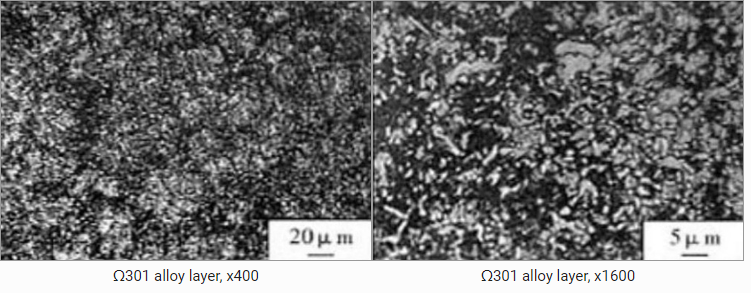Technical Information of Ω301 Alloy
In recent years, more and more reinforcing agents and fillers have been added to ordinary polymer materials. As a result, the core components of extruders and injection molding machines, such as screws and barrels have experienced a greater amount of wear and corrosion. To solve this problem, we have tested and successfully improved traditional nickel based alloy Ω301 elements. We employ a special technology to increase the tungsten carbide WC ratio to add more silicon carbide SiC ingredients. These more ceramic hard phases result in an increased, more uniform diffusing throughout the layer, meaning the bimetallic barrel is imbued with ultra-high abrasion resistance and superior corrosion resistance.
Tests showed our alloy to be the same or better than X-102 alloy from Xaloy company in the USA in many categories.
The hardness of Ω301 with new elements is HRC 55~65, its chemical compositions is as follows:| C | Mn | Si | B | Cr | Fe | Ni | Co | WC | SiC |
| 1.3~3.0 | 1.5~Max | 2.5~5.0 | 2.0~4.0 | 10~Max | 5.0~15.0 | Balance | 2.0~5.0 | 30~35 | 5.0~8.0 |
The physical properties of the standard iron-base/wear- resistant Ω301 after standard centrifugal casting:
| Specific Gravity (Mean) | Density (Pound/ Cubic foot) | Intensity of Tension (бb) | Breaking Strain (εfB) | Melting Point Range | Coefficient Thermal Expansion | Coefficient Thermal Conductivity | Modulus of elasticity ( kgf / mm ) |
| 12.00 ~ 12.50 | 0.43~0.48 | 60000 Pound/Inch2 | 0.18% | 1800°F~ 1900°F | 5.57×10-6 | 16.0~17.0 BTU/H/ Inch2/Inch0F | 18900 |
After centrifugal casting, alloy Ω301 is a hypoeutectic structure, like below:
The Ω301 alloy structure is mainly composed of nickel based sosoloid in dendrite form and interdendritic fine granular compound eutectic composition. The base phase containing Si, Ni, Cr of the nickel based sosoloid phase and theγphase, the hard phases are the black dots(Fe. Ni)23C6 and the carbide & boride of Cr. It has significant characteristics of micro fine microstructure and high degree of dispersion of hard phase (See right). In this microstructure, the standard Ω301 alloy hardness is HRC55~65. This high hardness performance of Ω301 alloy layer shows comprehensive results of its sosoloid strengthening of its dispersion and of its fine grain strengthening.

We know that the corrosion resistance of nickel based materials is beyond doubt. In dilute hydrochloric acid, sulfuric acid, sulfuric acid, dilute hydrofluoric acid and a variety of commonly used chemical solvents, nickel-base materials show off their superior corrosion resistance. Under the condition of high temperature casting, nickel carbides, silicon carbides, chromium carbides and other types of carbide hard phases are generated inside the nickel material, resulting in alloy Ω301. This gives the new material a high proportion of tungsten carbide particles and grants high abrasion resistance.
When processing certain plastic materials, some plastic formulas contain significant amounts of acidity that can lead to corrosion to your equipment. Alloy Ω301 is superior to iron-based components as it is highly resistant to these acidic compounds, resulting in the extended life of parts.
- Information
- Why is there uneven discharge of die head during extrusion?
- Under what circumstances should the filter be used in extrusion production and how should it be used?
- How should the structural form of the screw tip be selected?
- What are the factors influencing the bonding strength of the welded type extruded profiles during the production process?
- When the speed of the single screw extruder is very stable, the thickness of the extruded sheet fluctuates periodically, and the current of the extruder decreases correspondingly when the thickness of the sheet becomes thinner. What is the cause?
- When the twin-screw extruder forms the profile, the phenomenon of exhaust hole emitting material, how to solve it?
- What are the possible reasons for the separation of the co-extrusion layer and the foam layer of the core foam profile, and how to solve it?
- During the extrusion process of producing profiles, if there are air holes with material leakage, and at the same time the torque of the extruder increases, what is the cause? How should it be solved?
- Why does the single screw extruder suddenly stop automatically during the extrusion process? What are the causes and how to solve the problem?
- What are the main causes of bending deformation of hard profiles in the extrusion process and their control measures?
- Contact Us

-
Shanghai Omega Machinery Co., Ltd.
Add.: No.168 Hualian Road, Putuo District, Shanghai City
Contact: Williams Wu
Tel.: +86-021-69921527
Mobile: +86-18616920618
Fax: +86-021-69921567
E-mail: alphawu@126.com;965425705@qq.com
WeChat No.: wxsyyk1203will
-